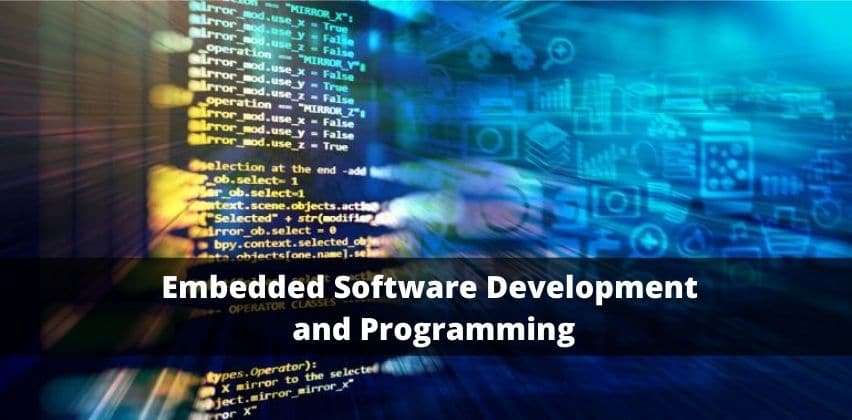
Embedded Software Development and Programming
Every day, people face and use dozens of devices whose functioning relies on microchips and circuit boards. These are gadgets with built-in software, such as photo cameras, fitness trackers, coffee machines, etc. Since many of them perform critical functions for some spheres of life, embedded software remains a hot topic.
If you want to find a reliable embedded systems company that can provide software development services to implement your idea of a smart digital device, you need to know the basic facts about embedded software programming.
Introduction
First, it should be noted that the development of traditional apps we install on laptops or smartphones differs from the creation of embedded software. Desktop or web applications are detached from the hardware they run on. In this case, the major task of app developers is to implement the logic that would ensure software functioning, and it doesn’t matter on what device this app will be installed.
On the contrary, embedded software is tightly connected with the equipment it runs on, and each line of built-in code can affect the hardware at the physical level. That’s why engineers working at a enterprise software development company must be able to read a circuit, data sheets and other documentation for electronic parts, understand the hardware component features and their interconnections.
In a nutshell, built-in software deals with non-computer devices and must be tailored to the physical requirements of hardware it controls and external environmental factors (e.g., humidity or pressure ).
Read more: Customized Software: What is it, Types, and Examples
Embedded System Definition
A real-world device with a programmable part based on a microchip that performs one or several predefined tasks is called an embedded system.
Components
Various systems may have various constituents relevant to the tasks they are supposed to perform and external requirements they operate in. However, there are two groups of obligatory components in any embedded system.
Hardware
This includes all physical parts composing the system:
- Body frame
- Central processing unit
- Actuators
- Memory devices
- Signal converters
- Input/output devices
- Sensors
- Cameras, scanners, modems, and other external equipment
Software
The software layer processes the information received from sensors and other physical elements and makes the system work. This may include the following pieces of software embedded in the hardware:
- Firmware
- Operating systems
- Drivers
- Middleware
- User application with an interface
Note that some solutions can do without middleware or OS, it all depends.
To build an embedded system, the top software development company should first decide on hardware parts, integrate and configure them, and then develop software according to this configuration. This means that a development team should comprise both specialists with strong hardware engineering skills and software programming experts.
Types of systems
The first group is distinguished according to the level of system independence:
- Stand-alone — function independently (e.g., an electronic thermometer).
- Networked — operate due to the network connection and are also called IoT systems (e.g., a smart home lighting system).
The second group is distinguished according to the level of system complexity:
- Small — use very little power resources and have primitive software.
- Medium — solutions with more complicated software which needs more resources.
- Complex — large and tricky solutions performing complicated, critical functions.
The third group is distinguished according to the system responsiveness:
- Real-time — must perform tasks within limited time frames, and this is critical (an example is intensive care equipment).
- Non-real-time — have no responsiveness limits.
Features
All embedded systems, though differ in functions, share some characteristics.
- Microprocessor/microcontroller is a chief component.
- Task-specific functionality of all built-in systems means they execute pre-programmed repeated functions throughout their lifecycle.
- Use specific operating systems or may function without them.
- Solutions with built-in software are resource challenged, meaning they are designed to operate in conditions of limited hardware resources.
- High reliability is an obligatory characteristic needed to ensure the consistent responsiveness of embedded devices.
General Development Process
Embedded software developers should work closely with hardware engineers to create a successful embedded solution.
Joint Design
Hardware engineers select the components needed to build a system. At this point, software developers join them to make sure they pick the right parts that will be able to provide the desired application functionality.
Design Review
Once the circuit diagram is ready, the developers work with the circuit designers to ensure that all signals and connections are correct and work as originally planned.
Hardware Emulation
Then, the developers at the best software development company create a test module or hardware emulator that will emulate signals and allow you to see the minimum functionality of the embedded software. This way, you can quickly iterate and develop separate code components.
Board Testing
Once an assembled board is ready, embedded system designers test its main functions to see if it can be powered on, if the board communicates correctly with peripherals, if the correct voltages are configured in the converters, etc.
Assembly of Drivers
If your project device is supposed to connect any peripherals or accessories, it needs a set of drivers. Good drivers are the backbone of any device. It’s better to spend more time writing good drivers than modifying code every time you need to add an external component (scanner, camera, etc.).
Logic Implementation
The last stage of the development process is when developers implement the logic in code that causes the device to do what it was designed to do. They are guided by specifications the hardware engineers prepared. At this stage, the device should start working, and you will only have to improve the code. Of course, development may involve multiple prototype iterations, and for each iteration, you will need to refine the code.
Read more: 7 Custom Software Development Mistakes Every Company Should Avoid
Embedded Software Development Tools
To develop embedded software, you need to choose a programming language, an operating system, a set of specific tools or an integrated development environment (IDE).
Operating Systems
Many built-in solutions require an operating system (OS). It acts as a mediator between hardware drivers and application logic. Most operating systems used in such solutions are real-time OS, which means they process information instantly and perform tasks within a strictly limited time period. RTOS is a crucial feature of devices that must control something in real time.
A traditional OS for embedded solutions is the open-source Linux. You can also consider ThreadX, Windows 10 IoT, and sometimes even Windows CE (but it’s outdated). For mobile embedded solutions, you can choose the Android OS.
Languages
For a long time, the traditional language for developing built-in software has been Assembly. Today, most embedded software developers use the C family of languages (C/C++/C#) because they are intuitive, fast, and memory-efficient.
You can also consider high-level programming languages such as Java, JavaScript, Python, and others for creating built-in solutions.
Tools
Developers also use the following tools for embedded engineering:
- An editor for writing source code and saving it as a text file.
- A compiler for converting the high-level code into the low-level.
- An assembler for transforming the code into the one machines understand.
- A debugger for testing the code.
- A linker for combining all code modules into a coherent program.
- An emulator for checking the program operation in real-life conditions.
Integrated Development Environments
IDEs are special platforms that combine all the necessary tools (debuggers, compilers, etc.), which is super convenient and saves much time.
The most popular integrated development environments for embedded solutions you should pay attention to are Qt, PyCharm, MPLAB X, Eclipse, Arduino, and many more.
Conclusion
Embedded solutions are the foundation of the electronics industry, as well as the backbone of our everyday life. People use devices with built-in software in manufacturing, healthcare, transportation, commerce, at home and in many other sectors. Consequently, the demand for skilled embedded software developers will grow in the foreseeable future.




